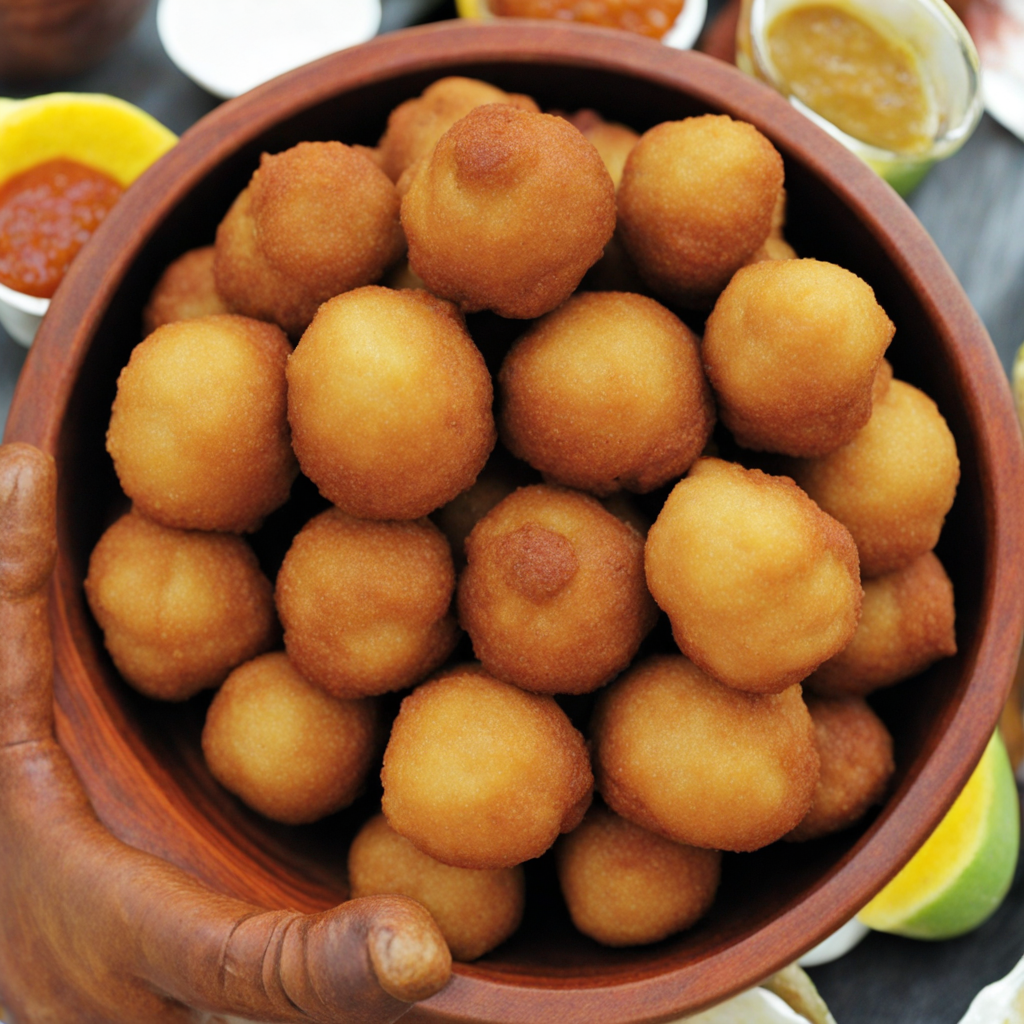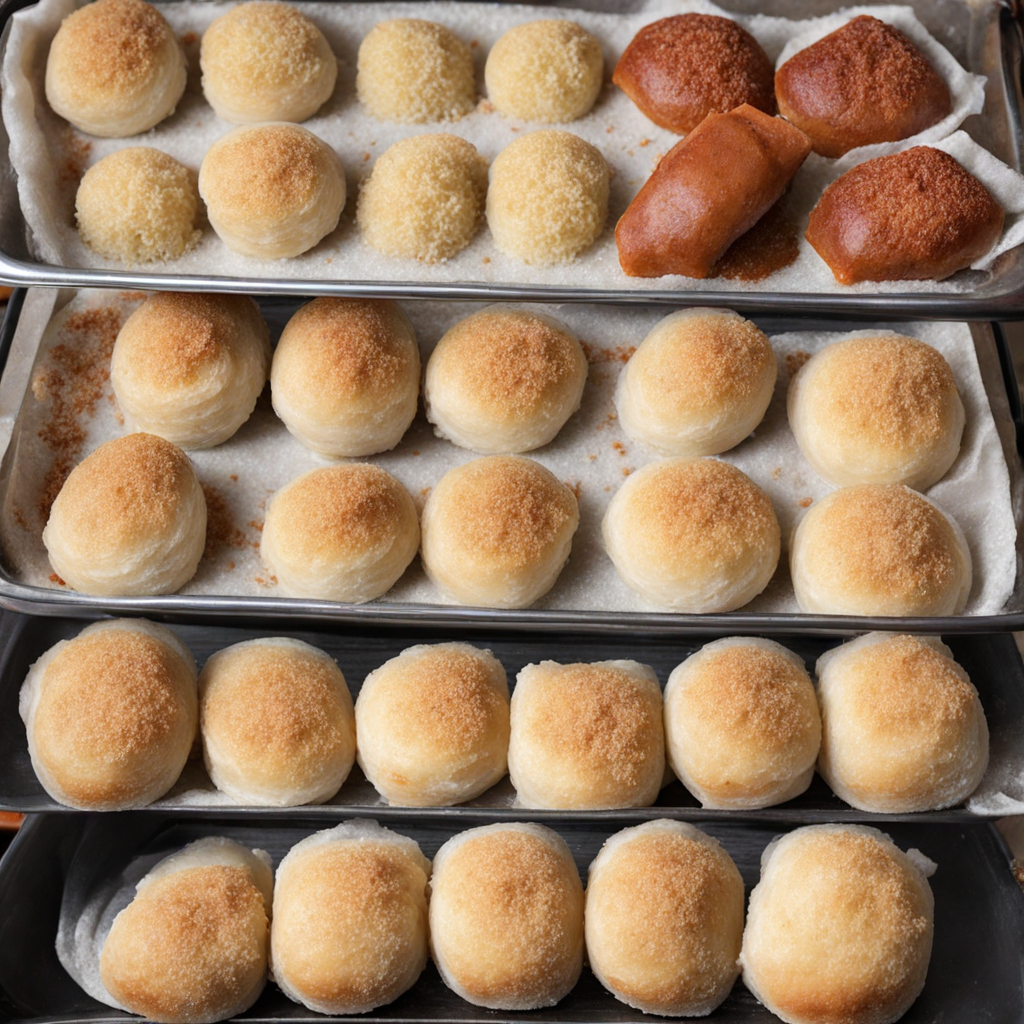Pholourie
Pholourie is a delightful snack originating from Guyana, characterized by its golden-brown, deep-fried exterior that encases a soft, fluffy interior. This flavorful treat is made from a spiced split pea flour batter that is combined with various herbs and seasonings, often including ingredients like turmeric, garlic, and green onions. The dough is typically rolled into small balls or fritters before being plunged into hot oil, resulting in a crispy outer layer that contrasts beautifully with its tender, savory core. The use of split peas not only lends a unique texture but also provides a subtle nuttiness that enhances the overall taste profile of the dish. Served hot, pholourie is often accompanied by a variety of dipping sauces, with mango chutney and pepper sauce being popular choices. The sweet and spicy flavors of the chutneys complement the savory notes of the fritters, creating a harmonious balance that excites the palate. This versatility allows pholourie to be enjoyed as a standalone snack or as part of a larger meal, making it a beloved staple in Guyanese cuisine. The aroma of the frying batter wafts through the air, inviting anyone nearby to indulge in these irresistible bites. Pholourie not only serves as a tasty treat but also carries cultural significance in Guyana, often enjoyed during festive occasions and gatherings. The communal aspect of sharing these delightful fritters fosters a sense of togetherness and celebration, making them a cherished part of the culinary landscape. Whether you're discovering pholourie for the first time or revisiting this classic dish, its unique flavor and texture promise to deliver a memorable experience that transports you to the vibrant streets of Guyana.
How It Became This Dish
The History of Pholourie: A Culinary Gem of Guyana Pholourie is a beloved snack in Guyanese cuisine that has captivated the taste buds of many with its delightful blend of spices and textures. This savory fried treat, often served with a tangy dipping sauce, is deeply rooted in the cultural fabric of Guyana, reflecting the nation’s diverse heritage. But what exactly is Pholourie, and how did it come to hold such a significant place in the hearts and palates of Guyanese people? Let us delve into its origins, cultural significance, and its evolution over time. #### Origins: A Culinary Crossroads Pholourie is thought to have its roots in Indian cuisine, resembling dishes such as bhaji or pakora. Its name is derived from the Hindi word "phool," meaning flower, which may reference the way the fried dough puffs up and blooms in the hot oil. The dish made its way to Guyana in the 19th century with the arrival of indentured laborers from India, who came to work on sugar plantations after the abolition of slavery. These laborers brought with them their culinary traditions, which were adapted and fused with local ingredients and cooking techniques. The primary components of Pholourie include split peas (often ground into a flour), spices like turmeric, cumin, and coriander, and sometimes finely chopped herbs such as cilantro or green onions. The dough is typically allowed to rest before being shaped into small balls or fritters and then deep-fried until golden brown. The result is a crispy exterior that gives way to a soft, spiced interior—an irresistible combination that has made it a favorite snack across Guyana. #### Cultural Significance: More Than Just a Snack Pholourie is more than a mere culinary delight; it serves as a symbol of Guyana's rich cultural tapestry. The dish is often associated with celebrations and communal gatherings, making it a staple at festivals, weddings, and family get-togethers. Its presence is especially noted during religious observances, such as Diwali, where it is commonly served alongside other traditional foods. In the context of Guyana's multicultural society, Pholourie embodies the blending of different traditions. It is enjoyed by people from various ethnic backgrounds, including East Indian, Afro-Guyanese, Amerindian, and Portuguese communities. This shared appreciation for Pholourie reflects the country's history of coexistence and cultural exchange, where flavors and cooking styles intermingle to create a unique culinary identity. Moreover, Pholourie is often paired with a variety of dipping sauces, such as mango chutney or tamarind sauce, which enhance its flavor profile and add further layers to the tasting experience. The act of making and sharing Pholourie has become a communal activity, fostering connections and reinforcing bonds among family and friends. #### Development Over Time: A Culinary Evolution As Guyana entered the 20th century, Pholourie began to evolve alongside the nation itself. Urbanization and globalization brought about changes in food production and consumption patterns. While traditional methods of preparation remained intact, new variations of Pholourie emerged to cater to evolving tastes and dietary preferences. Street vendors became a common sight in cities like Georgetown, where Pholourie is often sold hot and fresh. The snack gained popularity among not only locals but also tourists looking to experience authentic Guyanese street food. This accessibility contributed to its status as a national culinary symbol, representing the vibrancy of Guyanese culture. In recent decades, with the rise of social media and food blogs, Pholourie has gained international recognition. Food enthusiasts and chefs outside of Guyana have begun to experiment with the dish, incorporating diverse ingredients and modern techniques. Some adaptations include the use of sweet potatoes or other vegetables in the batter, while others may introduce global flavors like cheese or spicy sauces. These innovations showcase the versatility of Pholourie and its ability to transcend cultural boundaries while remaining true to its roots. #### Pholourie in Contemporary Guyana Today, Pholourie remains an integral part of Guyanese culinary culture. It is commonly found at local eateries, markets, and food festivals, where it continues to evoke nostalgia for many. The dish has also become a symbol of national pride, celebrated for its history and the stories it tells about the country’s diverse population. In Guyana, the preparation of Pholourie often involves a communal approach, with families gathering to cook together, share recipes, and pass down traditions to younger generations. This practice not only preserves the culinary heritage associated with Pholourie but also strengthens family ties and cultural identity. Moreover, the rise of food tourism has opened new avenues for Pholourie to shine on the international stage. Culinary tours in Guyana often highlight traditional dishes, including Pholourie, allowing visitors to connect with local culture through food. This growing interest has prompted chefs and home cooks alike to create their own interpretations of the dish, ensuring that it continues to evolve while honoring its historical significance. #### Conclusion: A Flavorful Legacy Pholourie is more than just a delicious snack; it is a testament to Guyana's rich culinary heritage and the harmonious blend of cultures that define the nation. From its origins among Indian indentured laborers to its status as a beloved street food today, Pholourie tells a story of adaptation, resilience, and community. The dish not only tantalizes the taste buds but also serves as a bridge between generations, fostering connections among people from diverse backgrounds. As Guyana continues to evolve and embrace its multicultural identity, Pholourie will undoubtedly remain a cherished part of its culinary landscape—an enduring symbol of flavor, history, and unity. Whether enjoyed at a festive gathering, from a street vendor, or in the comfort of one’s home, Pholourie is a dish that brings joy and togetherness, making it a true culinary gem of Guyana.
You may like
Discover local flavors from Guyana







